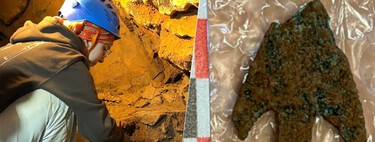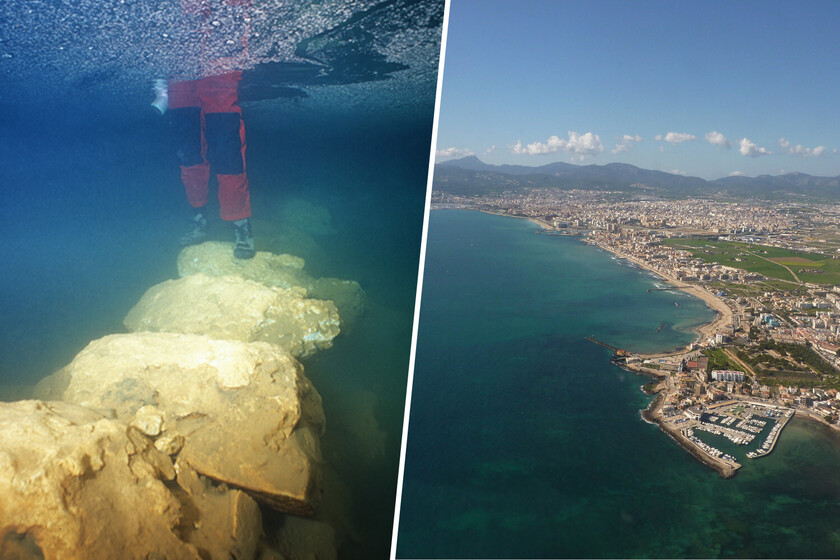A good handful of years ago, in 1999while studying caves in the area around Manacor, a group of researchers from the University of the Balearic Islands had a surprise: they discovered a small megalithic bridge of almost eight meters long, a now-submerged structure that was built thousands of years ago with large blocks of limestone rock to span a lake between two chambers. The discovery was fascinating; but it is only now, almost a quarter of a century later, that scientists have been able to understand how relevant it is to the history of Mallorca and the Mediterranean.
The reason: the find sheds light on the chronology of the island and its first settlements, with what that implies for the history of the Mediterranean.
A bridge to history. The protagonist of the study that has captured the attention of archaeologists dedicated to researching the Mediterranean is a small bridge, a megalithic construction of 7,6 m in length discovered in 1999 by a group of researchers from the University of the Balearic Islands.
The structure is formed by limestone blocks that reach the 1.3 m wide in some sections and are arranged one on top of the other. It is suspected that at one time, thousands of years ago, it was used to cross a lake and move between two elevated chambers of the Genovesa Cavein Manacor. Researchers also believe that construction may have started when the lake had 0,25 m depth, although with the passage of time the water has risen and now the viaduct is is submerged.
… and with surprises. If this small construction is in the news today, one that has aroused interest in both sides of the Atlantic, is because of what it can tell us about the colonization of Mallorca and, by extension, the western Mediterranean.
Like recalls CNNA few years after the discovery, a study concluded that the bridge was about 3,500 years old. The estimate was largely based on ceramic remains found in a chamber of the cave. Now a team of researchers from the universities of Harvard, New Mexico, South Florida (USF) and the UIB itself have recalculated that age, extending it significantly. At an article published in the magazine Communications earth & Environment argue that it was built at least 5,600 years ago.
How did they calculate it? Studying the bridge and environment. The cave has some flooded passages, but the researchers observed calcite incrustations formed by the sea. To be precise, they noticed that the bridge has a relevant detail: a curious light-colored marking on the upper part of the bridge, which led them to think that it could reveal calcite formation right at the height at which the water reached in the past. With that data, the height of the viaduct and a model of sea levels during the upper Holocene, they refined the calculation.
“We saw that the sea level rise during the Holocene coincided with the location of the bridge, so we decided to sample to relate the sea level oscillation to the depth of the bridge.” explains to EFE one of the authors of the study, Joan Fornós, from the area of Earth Sciences of the UIB.
“Thanks to radiometric dating we observed that there was a stabilization of the sea level occurred between 6,000 and 5,600 years ago that coincided with the white mark observed on the bridge. It is unlikely that it would have been built more than 6,000 years ago because the area it spans would not have been underwater.”

The value of a figure. The study allowed the researchers to estimate that the bridge was built nearly 6,000 years ago, an estimate that extends in more than 2,000 years the previous calculation. If the data is relevant, recalls the USF, it is not only because it allows us to know better a small hidden viaduct in the Balearic Islands.
What is really fascinating about the finding is that it sheds light on the history of Mallorca and part of the Mediterranean. And this is so because it provides information to answer a fundamental question: When did the first human settlements appear on the Balearic island? This is not a minor question. Mallorca is the sixth largest island of the Mediterranean Sea, but it is believed to have been one of the last to be colonized.
Checking the calendar. Some researchers had already suggested that the presence of humans in Mallorca may date back as far as 9,000 years ago, but there is a problem with that estimate, notes the USF“Inconsistencies and poor preservation of radiocarbon dated material”, such as bones and ceramics.
Other more recent studies have relied on charcoal, ash and bone remains located on the island to establish a chronology of human settlement dating back to 4,400 years ago. What we now know about the Genovesa cave bridge, an infrastructure built by humans at least 5,600 years ago, makes it possible to extend that timeline by more than a millennium.
A challenge to history. “Reconstructing the early human colonization of the Balearic Islands is a challenge because of the scarcity of archaeological evidence. Current knowledge places the human arrival around 4,400 years ago,” acknowledge experts in their study from Communications earth before slipping in that his analysis makes it possible to place the construction of the submerged bridge between 6,000 and 5,600 years ago.
“Subsequent sea level rise inundated the archaeological structure, ruling out later construction dates. This demonstrates that human presence on the island dates back at least 5600 years and possibly more than 6000.”
Beyond the Balearic Islands. “It is clear that man was there a thousand years earlier than previously estimated, and that there may have been a potential human presence on the island since approximately 9,000 years ago.” Fornós explains to EFE.
From the USF they give the finding a dimension even greater and claim that the study “sheds light” on human colonization of the western Mediterranean, “revealing that humans settled there much earlier than previously believed.” “This research challenges long-held assumptions and narrows the gap between island settlement timelines across the Mediterranean region.” stresses. The last nuance is not minor. Its authors insist that thanks to the Manacor bridge they have managed to “reduce the time gap between the settlements of the eastern and western Mediterranean”.
Images | University of South Florida (R. Landreth) y Car Rental (Flickr)
In Xataka | We have been obsessing for years about the meaning of Stonehenge. Its great enigma was another: how its six-ton altar traveled 700 km.
